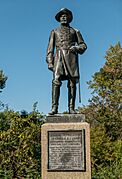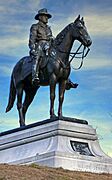Vicksburg National Military Park facts for kids
|
Vicksburg National Military Park
|
|

The Illinois Memorial in Vicksburg National Military Park
|
|
| Location | Vicksburg, Mississippi and Delta, Louisiana, United States |
|---|---|
| Area | 2,524 acres (10.2 km2; 3.9 sq mi) |
| Visitation | 532,444 (2015) |
| Website | Vicksburg National Military Park |
| NRHP reference No. | 66000100 |
Quick facts for kids Significant dates |
|
| Added to NRHP | October 15, 1966 |
| Designated NMP | February 21, 1899 |
Vicksburg National Military Park is a special place that remembers an important event in American history. It protects the area where the American Civil War Battle of Vicksburg happened. This battle took place from March 29 to July 4, 1863.
The park is in Vicksburg, Mississippi, right next to the Mississippi River. It also honors the larger Vicksburg Campaign, which was a series of events leading up to the main battle. You can see rebuilt forts and trenches there. These remind visitors of the 47-day siege that ended when the city gave up.
Winning this battle, along with another one at Port Hudson in Louisiana, gave the Union army control of the Mississippi River. This was a huge step towards ending the Civil War.
Contents
Exploring the Battlefield
The park is full of history! It has 1,325 monuments and markers that tell stories of the past. You can also explore 20 miles (32 km) of old trenches and earthworks. There's a 16-mile (26 km) road to drive around and a 12.5-mile (20 km) walking trail.
You can also see two old homes built before the war. There are 144 cannons placed around the park, just like they were during the battle. A special highlight is the restored gunboat USS Cairo. This ship was sunk on December 12, 1862, in the Yazoo River.
The Cairo was known as the "Hardluck Ironclad." It was the first U.S. ship ever sunk by a torpedo or mine. It was brought up from the Yazoo River in 1964.
Another interesting spot is the Grant's Canal site. Here, the Union Army tried to dig a canal. They hoped their ships could use it to avoid the Confederate cannons.
The Illinois State Memorial is also part of the park. It has 47 steps, one for each day the city of Vicksburg was under siege.
The Vicksburg Campaign: A Series of Battles
The Battle of Vicksburg was not just one fight. It was the end of a larger plan called the Vicksburg Campaign. This campaign involved many battles that led up to the siege of the city. Here are some of the key battles:
- Battle of Chickasaw Bayou
- Battle of Arkansas Post
- Battle of Grand Gulf (April 29, 1863)
- Battle of Snyder's Bluff (April 29 – May 1)
- Battle of Port Gibson (May 1)
- Battle of Raymond (May 12)
- Battle of Jackson (May 14)
- Battle of Champion Hill (May 16)
- Battle of Big Black River Bridge (May 17)
- Siege of Vicksburg (May 18 – July 4)
Vicksburg National Cemetery
Inside the park is the 116.28-acre (0.47 km²) Vicksburg National Cemetery. This cemetery is the final resting place for 18,244 people. A sad fact is that 12,954 of these soldiers are unidentified.
Most of the burials happened between 1866 and 1874, after the Civil War. Today, the cemetery is not open for new burials. It is a historic site that honors those who fought. There is one special grave for an airman from the Royal Australian Air Force who was buried during World War II.
Grant's Canal: A Bold Plan
The remains of Grant's Canal are a separate part of the military park. They are located across the river from Vicksburg, near Delta, Louisiana. This canal project was a big idea to change the course of the Mississippi River. The goal was to make the river bypass the Confederate cannons at Vicksburg.
President Abraham Lincoln approved the project. It was started in June 1862 by Union Army Major General Benjamin Butler. Later, Brigadier General Thomas Williams took over the work. However, the project stopped in July because many soldiers and former slaves working on it got sick. The river's water levels also dropped.
In January 1863, Union Army Major General Ulysses S. Grant ordered the canal project to restart. This was part of his Vicksburg Campaign plan. Brigadier General William T. Sherman was put in charge. Neither Grant nor Sherman thought the canal would work. But President Lincoln really liked the idea.
For different technical reasons, the canal never achieved its main goal. It did not change the river's course. However, Grant used the canal project to keep his troops busy. This was important during the long and difficult preparations for the Battle of Vicksburg.
History of the Park
The national military park was created on February 21, 1899. Its purpose was to "commemorate the siege and defense of Vicksburg." This means it was made to remember the important battle and how the city was defended.
The park and cemetery were first managed by the War Department. Then, on August 10, 1933, they were moved to the National Park Service (NPS). The NPS takes care of many important historical places in the U.S.
In the late 1950s, a small part of the park was given to the city. This allowed for the building of Interstate 20, a major highway. Even though some land was transferred, the NPS still takes care of the monuments on that land.
The park was officially listed on the National Register of Historic Places on October 15, 1966. This means it is recognized as a very important historical site. Today, more than half a million people visit the park every year to learn about this part of American history.
In 2000, the Mississippi House of Representatives approved money for a new monument. This monument was built to honor the African-American soldiers who fought in the United States Civil War.
See also
- Michigan Memorial
- Cedar Hill Cemetery (Vicksburg, Mississippi)







